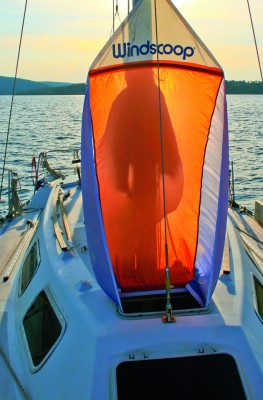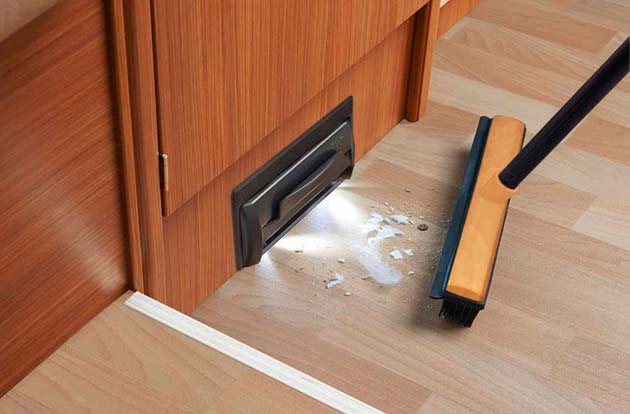7 easy ways to improve comfort on board
12 Unlimited power
Price guides: solar £200-£500 per 100W; hydrogenerator £2,000-£3,300; wind generator £1,400-£2,300; fuel cell £2,000-£5,000
Life on board can be transformed if you never have to worry about the amount of electrical power you consume. Much has changed in this respect over the past decade.
Many of today’s appliances, including LED lighting, iPads and tablets, and low-energy TV screens draw far less current than their forebears. The cost of solar power has dropped significantly at the same time as efficiencies have improved, and efficient hydrogenerators that are easy to deploy have also been developed.
For yachts that don’t want to install a 240V generator, fuel cells may be a viable way to top up batteries on an occasional basis. For more on this subject see the June 2015 issue or our feature online.
Daily power outputs can vary considerably, but rough rule of thumb figures give the following averages:
Solar: 25ah/day for each 100W of panel
Hydrogenerator: 150-200ah/day at six knots average boat speed
Wind turbine (90cm diameter): 100ah/day
Fuel cell: 100-150ah/day
13 Ample fresh water
Price guide: £5,700 to £7,700
Recent developments have made low-voltage watermakers increasingly viable, with 30lt/hr models, such as the Tecnicomar Oasi 30 from Aquamare Marine, consuming as little as 13 amps at 12V and weighing just 20kg. aquamare.co.uk
Yachting World’s ARC Survey consistently shows that fitting a foot pump, along with a saltwater pump at the galley, is invaluable for ocean crossings.
14 Dump the bottled water
Price guide: £250 to £400
Over the course of a few months even a small crew can get through an enormous amount of bottled water. Even disregarding environmental considerations, this can be an absolute pain to stow as well as presenting a logistical problem to lug it on board in the first place.
However, for a modest cost you can fit an ultra-fine water filter that will remove all bacteria and viruses from tanked water. The key to this is a filter of less than 0.4 micron size, such as the Seagull IV X1F and Nature Pure Ultrafine models from General Ecology. purewateronline.co.uk/
These work with standard onboard water pressure and can be configured to filter all tanked water, or can be plumbed into a separate faucet so that only drinking water is filtered, which will extend each cartridge’s 3-3,800lt lifespan.
They can also be used for the supply to an icemaker. Replacement cartridges range from £77 to £99.
15 Ventilation: improve airflow below
Windscoop: approx £50-70
Don’t wait until you’re baking under a relentless sun before considering how to improve life below decks. The most important single thing is to ensure there’s a good flow of air through the boat.
This is relatively easy to achieve if you’re at anchor, when a simple windscoop or two will do the trick, as the boat will tend to be head to wind most of the time.
But it can be difficult to promote a good airflow in quarter cabins and aft cabins. It helps if the hatches are hinged on the aft edge, but decent fans may still be needed to supplement the airflow.
Don’t stint on the quality – only the best combine a decent throughput with the kind of quiet, vibration-free running essential to prevent the fan disturbing your sleep.
The Caframo Ultimate 757 is a favourite of many long-term cruisers thanks to its high flow rate, low power consumption and quiet running. Significantly, the blades have shock-absorbing leading edges, which mean a safety cage is not essential in most installations, which markedly improves the fan’s efficiency. caframolifestylesolutions.com
16 A proper mattress
Price guide: £600-£2,000 (king-size double berth)
There’s no reason why you shouldn’t be as comfortable in bed afloat as you are at home. There are a number of companies that offer pocket-sprung mattresses custom-built to fit the unusual shape of yacht berths and can incorporate soft, medium or firm springs, or a split mattress.
To prevent mouldy bedding it’s essential to add ventilation matting beneath the mattresses to cut down on condensation. The industry standard is a mesh anti-condensation layer of around 1cm which provides for ample airflow, as well as keeping the mattress above any condensation that does form: £30 per bunk.
17 Cleaning made easy
Price guide: £160-£400
No one wants to spend any more of their time afloat than is absolutely essential engaged in domestic chores. Dometic’s new central vacuum system is one way to ensure floors and upholstery can be quickly cleaned at the touch of a button.
It’s a high-suction, compact unit that can be easily installed in a locker, and the 12m hose allows it to reach anywhere on the boat. The biggest drawback is that this is a high-power unit drawing 950W at mains voltages. This is unlikely to pose a problem for larger yachts with a generator, but it may rule out its use on smaller vessels. The price is around £400. dometic.co.uk
A lower-cost and lower-power alternative is the Dyson DC34 handheld cordless. This consumes 65W and weighs 1.3kg, yet packs a lot more power than typical cordless models. Expect to pay £150. dyson.co.uk
18 Air conditioning
Price guide: from £2,000 to £4,000 per unit
Not so long ago this was solely the preserve of the biggest yachts, but the introduction of compact standalone units makes it viable for smaller vessels.
Granted, to use it while at anchor you’d also need to run a generator all the time, but the biggest benefit of aircon is when you’re in a marina berth with shore power.
As well as the boat not lying head to wind in a berth, as you’re closer to shore the wind strength is likely to be diminished and temperatures will be higher at night – three reasons why aircon can be a boon.
The smallest unit we’ve found is the 3,500 BTU/hr (equivalent 1kW) Compact 3.5 Quattro model from Climma Marine Air Conditioning, but models go up to 17,000 BTU/hr. http://penguinfrigo.co.uk
More than one can be fitted to create a simple air conditioning system – the Gunboat 66 Tiger Lily has two of Dometic’s 16,000 BTU/hr Vector Turbo units to cool her bridgedeck saloon, plus further 8,000 BTU/hr units for each stateroom.
It’s worth noting, if you’re also planning to spend time in cooler waters, these systems can also be used for (electric) heating of the vessel. dometic.co.uk
Great galley upgrades
19 Replace the cooker
Price guide: £2,100 to £4,000
GN Espace (gn-espace.com) has developed a range of marine cookers that address typical problems.
All have a full-width grill and an oven with two or three-level cooking. The company also takes care to insulate ovens to the highest levels. This saves gas – by up to 50 per cent – while reducing the heat transmitted to the rest of the boat.
Hobs range from a standard two-burner unit up to a large five-burner model that includes one that’s sufficiently powerful to use a wok.
Another option is to get rid of the gas system entirely and convert to electric. Induction types are more efficient, so will draw a little less power and will contribute far less to creating unwanted cabin heat than gas cookers.
20 Organise the space
Price guide: £1,000 to £2,000
This is an area that’s all too frequently compromised in the typical yacht galley – however, it’s also one that GN-Espace has addressed.
For example, the Gastronorm sinks use ideas from professional catering to create an efficient multifunction food preparation and washing up area.
21 Improve refrigeration
Price guide: £1,000 to £15,000+
Key considerations include excellent insulation – the thicker the better – and a location for the compressor that provides adequate ventilation. It’s also worth considering water-cooling systems, which reduce the coolant temperatures and therefore significantly reduce power consumption.
A new small top loading fridge can be bought for well under £1,000. Water cooling systems start for less than £400 for the Frigoboat Keel Cooler. http://penguinfrigo.co.uk









